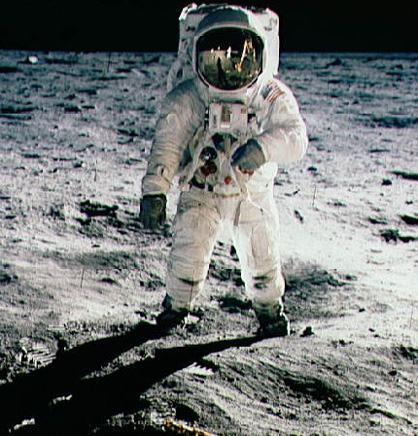PRESIDENT KENNEDY
John F. Kennedy had been inaugurated as president of the United
States in January 1961. He faced an early embarrassment over
the Bay of Pigs fiasco in Cuba. Afterwards, he needed some tangible
victory to deflect attention away from this fiasco and to also
show America's superiority over the Soviet Union.
On May 25, 1961, Kennedy gave a speech to congress, "First
I believe that this nation should commit itself to achieving
the goal, before this decade is out, of landing a man on the
moon and returning him safely to earth."
Congress funded Kennedy's goal.
ASTRONAUTS
The Apollo 11 astronauts were Neil Armstrong, Buzz Aldrin, and
Michael Collins. Armstrong was the commander.
They named their Command Module, "Columbia;" and their
Lunar Module, "Eagle."
BOOSTER
The Saturn V rocket was used as a booster for the Apollo 11 spacecraft.
Wernher von Braun led the NASA team which developed the Saturn
rocket.
The total height of the Apollo-Saturn V rocket was 363 feet,
at launch.
LAUNCH
The Apollo 11 spacecraft was launched from Cape Canaveral, Florida
on Wednesday, July 16, 1969.
It accelerated to a speed of 25,000 miles per hour in order to
"escape" the Earth's gravity.
The Apollo 11 spacecraft then separated into the Lunar Module
and the Command Module. Armstrong and Aldrin descended to the
Moon's surface in the Lunar Module. Michael Collins remained
in the Command Module.
LUNAR LANDING
The Apollo 11 Lunar Module landed in the southern portion of
the Sea of Tranquility. The initial site was chosen from telescopic
and lunar orbit photography. It was called Site 2 by the U.S.
Geological Survey's Center of Astrogeology.
The Lunar Module overshot this site due to a slight navigational
error and a faster than intended descent speed. Furthermore,
Neil Armstrong had to maneuver the Lunar Module to avoid landing
in craters or impacting against
boulders.
During descent, the low-fuel light came on in the Lunar Module,
causing mission controllers to nearly panic. Mission controllers
estimated that there were somewhere between 13 and 20 seconds
of fuel left when the lunar module finally landed.
Don Lind was one of the mission controllers and later a shuttle
astronaut. He wrote in his own book that, "...when the fuel
stopped sloshing around in the tank and we could read the gauges
more accurately, there were really 42 seconds of fuel left......."
Nevertheless, Lind goes on to praise Armstrong's ability to perform
so well under those trying conditions.
ASTRONAUTS SET FOOT ON THE MOON
Neil Armstrong became the first man to set foot on the moon.
He did this on July 20, 1969. As he stepped down onto the lunar
surface, he said, "That's one small step for man, one giant
leap for mankind."
Buzz Aldrin accompanied Neil Armstrong to the lunar surface.
Aldrin described the Moon as: "Beautiful, beautiful. Magnificent
desolation."
LUNAR GEOLOGY
Armstrong and Aldrin collected 40 pounds of Moon rocks, erected
an American flag, and set up a seismometer to measure "moonquakes."
Geologists studied these moon rock samples after the mission.
The geologists determined that the Moon is composed largely of
igneous rock, which is formed from a molten state.
Furthermore, the rocks on the Moon's surface have also been smashed
by impacts with meteorites, and the fragments are sometimes welded
together by lava. Breccias are composite rocks formed from all
other rock types through crushing, mixing, and sintering during
meteorite impacts. The fine dust resulting from these impacts
is called regolith.
LUNAR GRAVITY
Note that the gravitational acceleration on the Moon is only
1/6 G. On the Earth, gravity is 1 G. Aldrin noted that his weight
was much less on the Moon but that his mass was the same. Thus
he was able to hop and skip about
the Moon with relative ease, but stopping took some effort.
TIMELINE
Here is the Apollo 11 mission timeline:
Liftoff from Cape Canaveral, Florida:
Wednesday, July 16, 1969, 8:32:00 a.m. EST
Lunar Module touches down on the Moon:
Sunday, July 20, 1969, 3:17:40 p.m. EST
Neil Armstrong begins extravehicular activity
(exits Lunar Module and begins slow climb down ladder):
Sunday, July 20, 1969, 9:39:33 p.m. EST
Neil Armstrong steps down on lunar surface:
Sunday, July 20, 1969, 9:56:15 p.m. EST
End of lunar extravehicular activity (Moon walk):
Monday, July 21, 1969, 12:11:13 a.m. EST
Apollo 11 Command Module splashes down in Pacific Ocean:
July 24, 1969, 11:50:53 a.m. EST
(Timeline Reference: NASA SP-4012 NASA Historic Data Book Volume
II)
RETURN TO EARTH
The recovery ship was the USS Hornet.
The three Apollo 11 astronauts were kept in the Mobile Quarantine
Facility (MQF) until August 10. During this time, doctors examined
the astronauts to determine whether they had brought back any
germs from the Moon.
BACKUP CREW
The backup crew were James A. Lovell, commander; William A. Anders,
command module pilot; and Fred W. Haise, lunar module pilot.
These three astronauts later flew on the Apollo 13 mission.
CONCLUSION
The purpose of sending astronauts to the Moon was to achieve
a "political goal," namely proving to the world that
the U.S. was superior to the Soviet Union. Science and engineering
objectives were less important.
Americans have a short attention span. The Viet Nam war, Watergate,
Arab Oil Embargo, urban unrest, and other issues soon rendered
the U.S. space program as a low priority. Apollo 17 became the
last lunar mission, in December 1972.
The U.S. thus won the "Space Race." The "Cold
War," however, continued until the breakup of the Soviet
Union, about twenty years later.
REFERENCES
Books:
1. Buzz Aldrin and Malcolm McConnell, Men from Earth, Bantam,
New York, 1989.
2. Michael Collins, Liftoff, Grove Press, New York, 1988.
|

